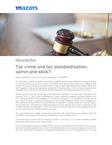
Tax crime and tax standardization; carrot and stick?
The expression "carrot and stick" comes from a motivational theory that indicates that to get a donkey to move you have to put a carrot in front of it and hit it from behind with a stick. It is a metaphor that refers to the use of rewards and punishments in order to induce desired behavior (Abella, Diana). But what happens if that carrot is poisoned, and when the donkey eats it, not only dies, but continues to be beaten with a stick? How would this affect the behavior of the other donkeys in the corral?
At the opening of the 41st Conference of the Colombian Institute of Tax Law held in Cartagena from February 15 to 17, 2017, both the Minister of Finance, Mauricio Cardenas, and the Director of the Dian, Santiago Rojas, invited taxpayers to normalize, during 2017, their omitted assets so that the tax crime of omission of assets and inclusion of non-existent liabilities would not be configured on them. While the director of the Dian said that the normalization of assets would never be seen again, since it had been very difficult to achieve its approval and to get the Court "not to overthrow it", the minister said that, for taxpayers, in 2017 the "carrot and stick" method would be applied, being the carrot the normalization and the stick the tax crime.
Thus, according to the minister, the tax crime is the stick with which those who normalize in 2017 will be beaten, an insinuation that is totally inadmissible in a Social State of Law.
As we have said, the tax crime of omission of assets or inclusion of non-existent liabilities, besides being unconstitutional, is highly inconvenient.
It is unconstitutional because it violates Article 33 of the Constitution, which states that no one can be forced to testify against himself. Such unconstitutionality occurs because, being in force for the 2017 tax year the tax normalization tax whose generating fact is to have omitted assets (art. 35, Law 1739 of 2014), the criminal type of omission of assets, whose governing verb is, among others, to omit assets, was created starting also from the 2017 tax year. In other words, for 2017 a criminal type that criminalizes the omission of assets coexists with a tax (which is not an amnesty according to the Constitutional Court ruling C-551/2015) that obliges the taxpayer to declare such omitted assets, paying for it a reduced tax of 13%. Thus, whoever must declare the tax normalization tax -by doing so- will be confessing, against his will and against his fundamental right not to declare against himself, the existence of a crime of which he himself is the author.
It is inconvenient because, in the opinion of the Superior Council of Criminal Policy (governmental body in charge of advising the National Government in the implementation of the Criminal Policy), the criminal type (i) punishes with equal severity different types of conducts (omission of assets, inaccurate presentation of information of assets and declaration of non-existent liabilities) that impact in different ways the protected legal assets of the State, (ii) it is not necessary since there are other criminal offenses such as forgery in private documents and money laundering that are sufficiently important to serve as a tool for the prosecution of tax evasion, (iii) it turns the criminal process into a system for the collection of tax obligations, since the payment of these extinguishes (and does not mitigate) the criminal action, (iv) it considers the taxpayer as the perpetrator of the conduct and not the one who benefits in terms of assets and taxes from the infraction. Likewise, in the opinion of the Colombian Institute of Tax Law, the criminal type under study causes the taxpayer to be penalized multiple times (penalty for inaccuracy, for omission of assets, and the 20% penalty within the criminal proceeding), thus violating the principle of non bis in idem.


